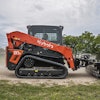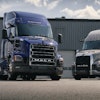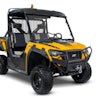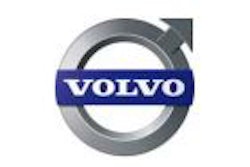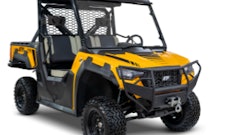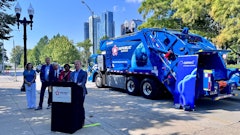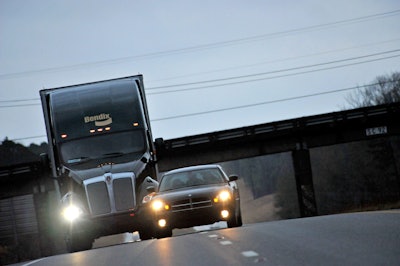
Over the past decade there have been major advancements in safety technology utilized in Class 8 over-the-road trucks.
Roll stability technology and electronic stability control have emerged and matured over this time frame and have become popular options.
The potential for increased safety with these systems caught the attention of regulators, and on June 23, 2015, the National Highway Traffic Safety Administration (NHTSA) finalized Federal Motor Vehicle Standard No. 136, which requires electronic stability control systems on all new tractors and buses weighing greater than 26,000 lbs. GVWR. The rule applies to new three-axle truck tractors manufactured on or after August 1, 2017, and all other truck tractors, including two-axle models, in 2019. Straight trucks are not included in the mandate.
Meanwhile, collision avoidance systems have also become prevalent. These systems use radar and/or camera technology and often feature lane departure warning and anti-lock braking systems with rollover protection stability systems. They are the next logical step building on the foundation of electronic stability control. Now many of these technologies are migrating to the vocational truck market.
“As collision avoidance systems become more widely used, and prices start declining with a technology that becomes more stable, we will likely start seeing this become more popular in vocational trucks,” says Kurt Swihart, Kenworth marketing director. But there are admittedly a few challenges to moving these systems off-road. “With combined radar and camera systems that are becoming available, there are components mounted at the furthest forward part of the truck in the bumper that can be fragile for typical vocational use but are protected as much as possible.”
Implementing collision avoidance systems in dirty construction environments may also involve a little more maintenance, such as periodically cleaning camera lenses.
Then there are the technical challenges of integrating the systems on vocational trucks. “One of the things that make it a little more challenging for a work truck are the multiple configurations,” says Chad Semler, director of marketing for severe service, Navistar.
Camera and radar systems on the front may have to be relocated due to winches or other equipment. With rollover stability systems, there are many variances in the center of gravity depending on the body mounted.
“These systems, by default, require electronic stability control. They have to be calibrated for the application, especially something with a high center of gravity,” Semler explains. “So it is a little more complicated and requires various calibrations depending upon what the truck is doing.” Ready-mix trucks are an example of a high center of gravity application where electronic stability control is already widely used.
A Fusion of Systems
The Bendix Wingman Fusion driver assistance system is among the latest active safety and braking systems, and is available as a factory-installed option from most major North American truck manufacturers. It is currently available on an array of medium- and heavy-duty models.
Wingman Fusion has been offered on Navistar’s on-highway International ProStar since the system’s unveiling, and was added as an option on the medium-duty International DuraStar line earlier in 2016. Kenworth Truck Company began offering the system as an option on its T680 and T880 Class 8 trucks in February 2016, and in October, announced its availability on the medium-duty T270 and T370 models. Peterbilt Motors Company added it as an option on its Model 579 and 567 highway tractors and vocational trucks in summer 2016. And this past October, Volvo Trucks North America unveiled Volvo Active Driver Assist — which utilizes the collision mitigation technology of Wingman Fusion — as a factory installed option on its VNL and VNM series models.
[VIDEO] International Adds Bendix Wingman Fusion to DuraStar
Unlike radar-only systems, Wingman Fusion combines and cross checks information from multiple sources to deliver enhanced rear-end collision mitigation; alerts when speeding; and braking on stationary vehicles. Built on the Bendix ESP Electronic Stability Program, Wingman Fusion gathers input through radar, video and the vehicle’s brakes and uses it to help drivers avoid rollovers and loss of control and sideswipe crashes, while prioritizing alerts to help reduce driver distraction.
The technology can serve as a framework for what’s to come. “As we look ahead, technologies that combine radar and camera sensors are important stepping stones to a potential autonomous trucking future,” says Fred Andersky, director of customer solutions, Bendix.
Driver Assistance Reduces Risks
Equipment Today gained first-hand experience with the Wingman Fusion driver assistance technology at the PACCAR Technical Center in Mt. Vernon, WA. The system was installed in a Kenworth T680 and the test truck was put through several scenarios that replicated real-life hazards. We witnessed the system response directly from inside the cab.
The experience demonstrated how quickly the system can react and apply emergency braking that literally pushes the truck to its limits. The truck safely prevented all simulated collisions that otherwise could have proved catastrophic.
Andersky notes that many of the capabilities of Wingman Fusion are due to the addition of the camera. Bendix also offers a radar-only system called Wingman Advanced. The key to both systems is active braking.
Wingman Advanced brings together adaptive cruise control with braking features, collision mitigation technology and electronic stability system technology. A fleet can benefit from this combination of active safety technologies by helping drivers avoid collisions, rollovers and loss of control situations.
When the distance between a driver’s truck and the vehicle they’re following starts to close, Wingman Advanced provides the driver following distance alerts and, if necessary, will apply the brakes to help the driver potentially avoid the collision, or help reduce its severity. Unique to Wingman Advanced are stationary object alerts. These alerts give the driver a warning (up to 3 seconds) of a metallic object, such as a stalled car, blocking the lane of travel.
Wingman Fusion integrates a camera, radar and the brake system. Input from the camera and radar are linked to each other, sharing information and communicating with the brakes.
“Keep in mind that all of these features are one system,” says Andersky. “Instead of having a separate lane departure and a separate collision mitigation system, it is all one, which allows us to prioritize the most important alert instead of multiple alerts going off at once.” This is a key feature because it doesn’t overwhelm the driver and simply alerts him or her of the most pressing danger.
There are a series of warnings that intensify as the risk increases. “Think of it as close, closer and closest in terms of alerts,” says Andersky.
Camera technology allows the system to have capabilities not possible with only radar. “The camera gives us the ability to do lane departure warnings,” notes Andersky. “If the driver goes 6 in. over the line, the system will give him an alert. If he uses his turn signal, the system will not give him an alert because it knows the driver wants to make that maneuver.”
Premium Safety System Options Emerge
Other technologies to increase safety and reduce fatigue — such as the RollTek rollover safety system and Bose Ride seat technology — are also making their way from on-highway to vocational application. “We are seeing interest in both of those products for vocational applications,” says Steve Gilligan, vice president of product marketing, Navistar.
“The Bose Ride seats were first envisioned as being primarily an on-highway premium seat,” says Gilligan. The system uses technology that senses, analyzes and then counteracts forces from the road. This approach significantly reduces the harmful shaking and jarring heavy-duty truck drivers experience every day on the job. “We are actually seeing quite a bit of interest in the vocational markets and the severe applications where the driver has a tendency to get tossed around quite a bit. One of the largest orders that we have seen for those seats was a vocational user.”
The Bose Ride system is designed to reduce driver fatigue and pain, a common problem with heavy truck operators. A powerful electromagnetic motor counteracts the movement of the cab floor to improve ride quality. This allows drivers to stay focused, recover from the day more quickly and extend their driving careers.
Likewise, there has been a lot of interest in the RollTek advanced rollover protection technology from IMMI that incorporates seat belt, seat and airbag technologies to enhance operator safety. When RollTek senses an impending rollover, it tightens the seat belt; the suspension seat is pulled to its lowest level to increase survivable space; and the side airbag deploys to cushion the head and neck.
The purpose of the RollTek system is to significantly reduce the potential of serious injury in a rollover in case the driver exceeds the capabilities of the available electronic stability systems. RollTek is designed to only activate when a rollover is detected which is unrecoverable.
For many vocational construction truck applications, use of this technology requires consultation with product experts. Semler explains that off-highway applications require different calibrations due to the nature of the off-road terrain and its constantly changing pitches.
Keeping up with these latest advances in safety technology is important to protect your current driver base and possibly extend their careers — especially critical given the current and growing driver shortage. It also promises to reduce risks when vehicles are in the hands of less experienced drivers or new hires.
There was a time in the not-so-distant past when anti-lock brakes represented the pinnacle of heavy truck safety systems. Now, the emergence of sophisticated technology in over-the-road trucks is poised to rapidly expand and improve the safety of your vocational fleet, as well.

